10 tips for sewing denim
Have you guys had a chance to check out the 2016 Refashioners challenge this year?
Every year, Portia over at Makery enlists a bunch of sewing folks to take on a refashioning challenge. This year, the theme was jeans. The idea is to take one or more pairs of jeans and transform them into something new.
Four of us from Colette HQ participated and it was really interesting to see how each of our styles played out within these constraints. I’ll share what Delaney and I made today (with Meg and Anna’s project later this week), along with some of my favorite tips for sewing denim, below.
What Delaney and I made
Delaney and I both went for something a little glam and body conscious. I don’t normally go for dresses that are short AND tight, but I really wanted to make a dress and managed to squeeze out as many inches of fabric as I could by using mostly small pattern pieces.
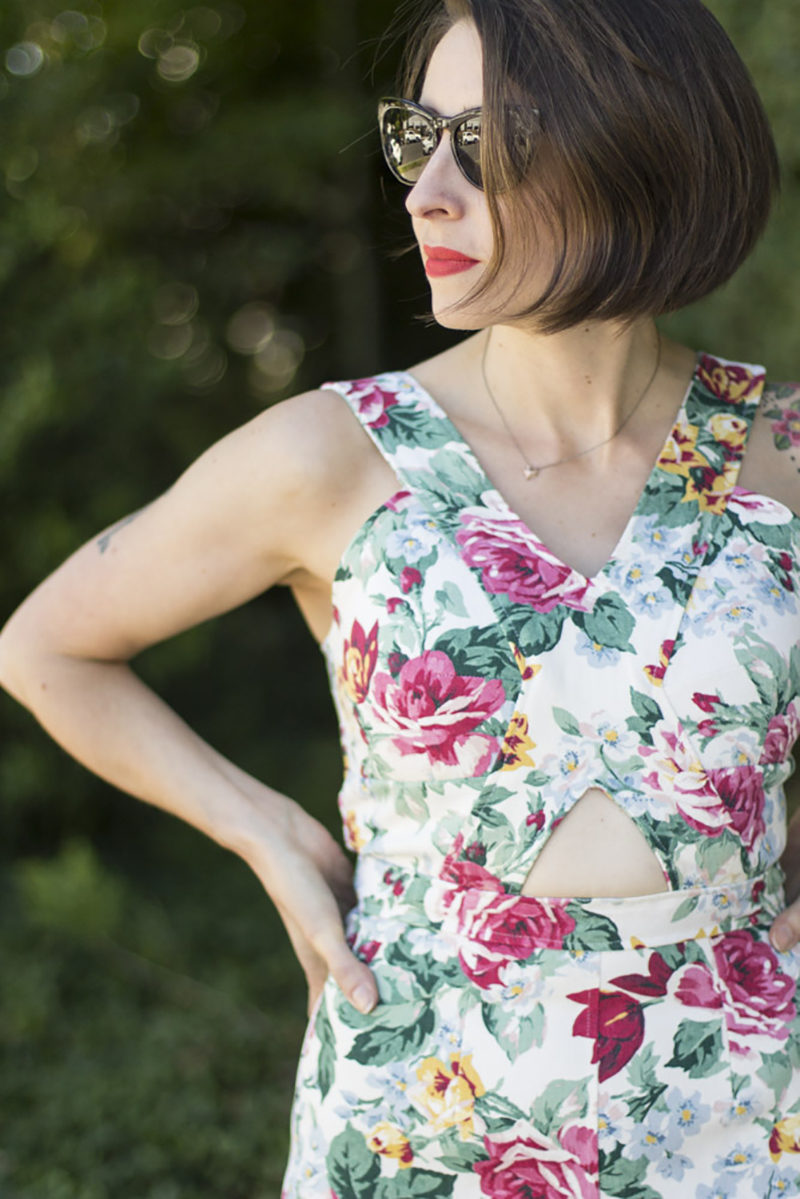
So yeah. Not only short and tight, but with a little window to show off my pasty belly-flesh. My inspiration was this Stella McCartney dress. I made mine pretty similar, but added more seams to the bodice for a better fit around the bust.
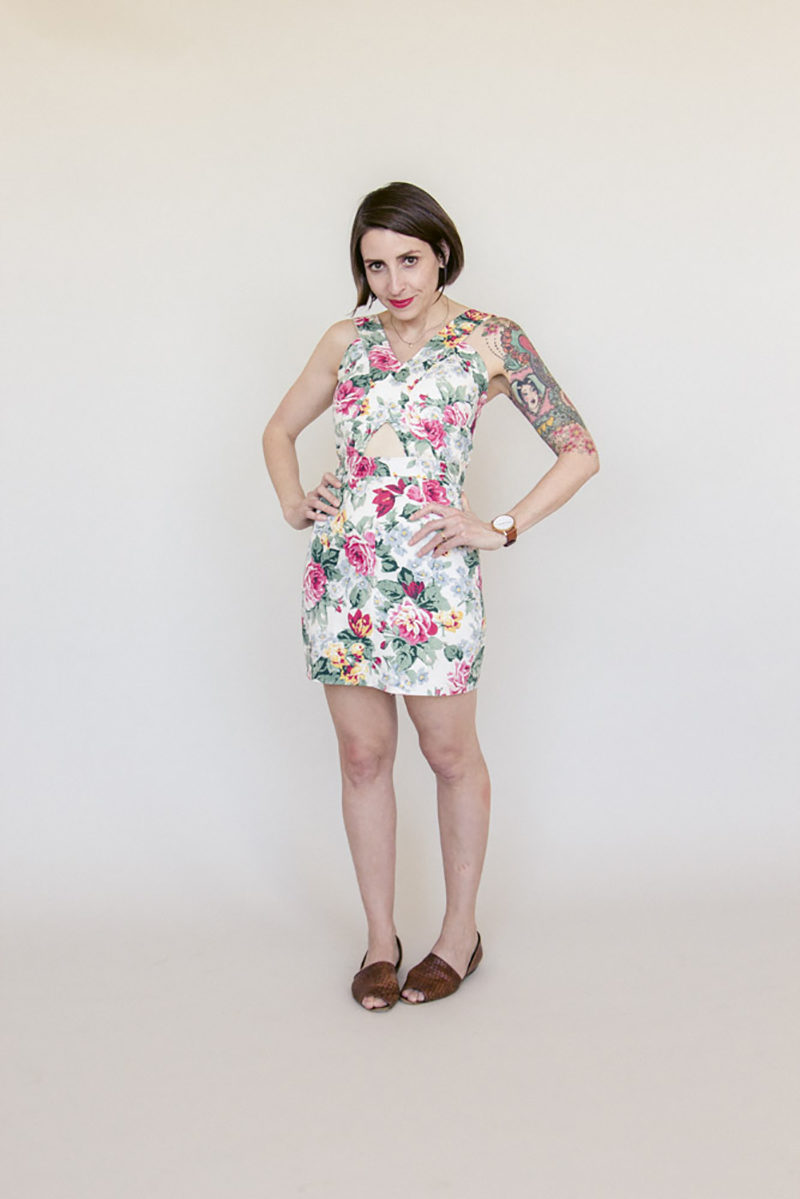
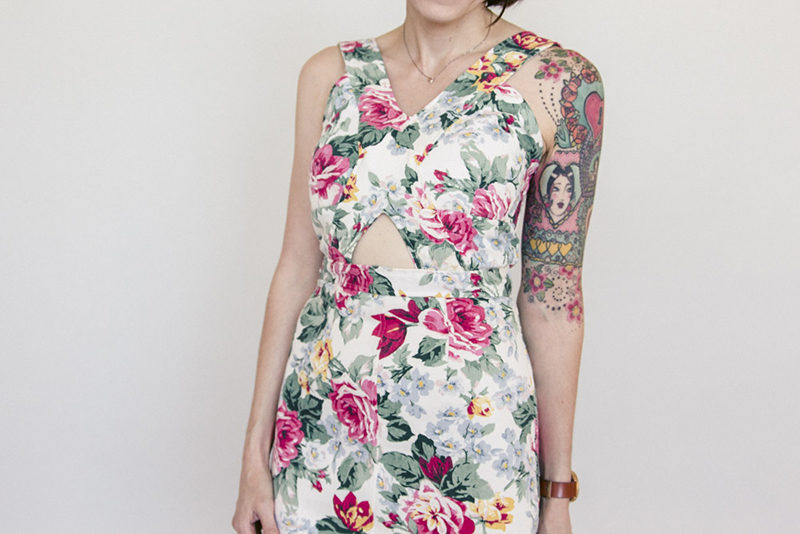


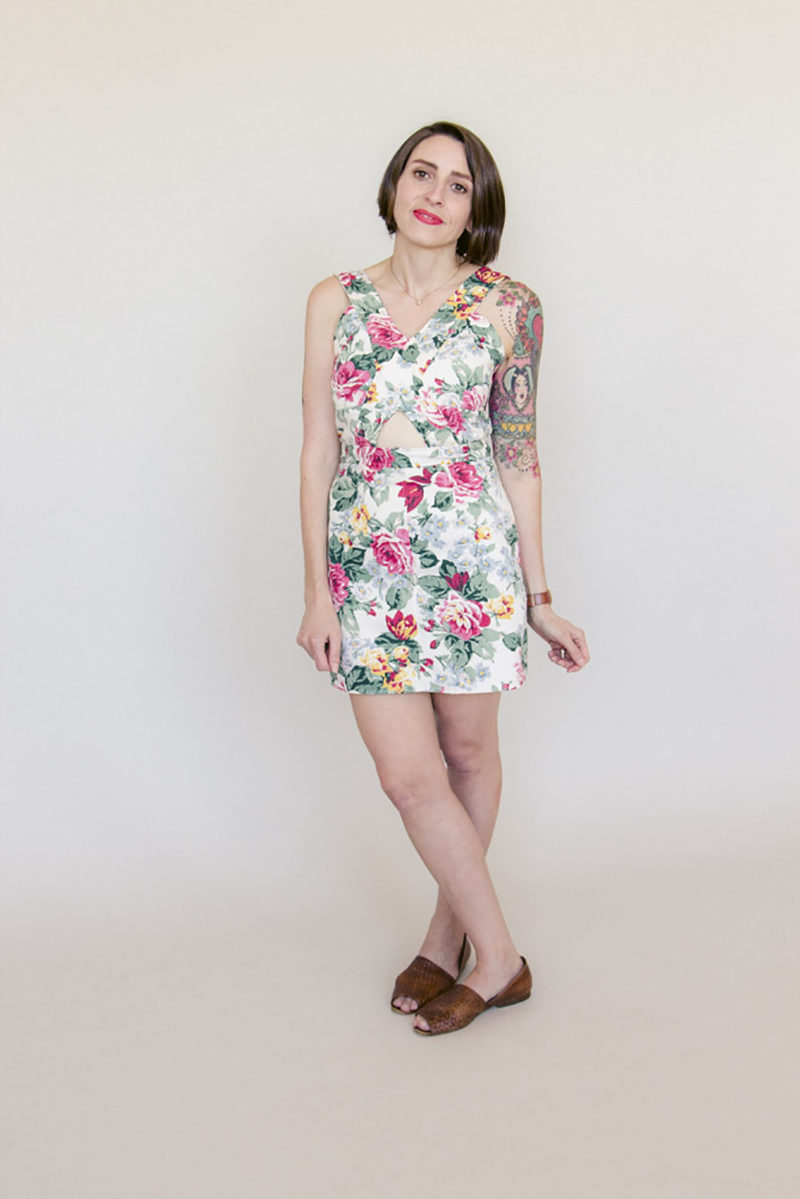
I mostly draped the pattern for my dress right on the form, made a single muslin, and sewed ‘er up. While I was originally intending to find a midtone denim, when I saw a pair of loud 90’s floral jeans, the fabric screamed my name and I had to obey the command of the sewing gods.


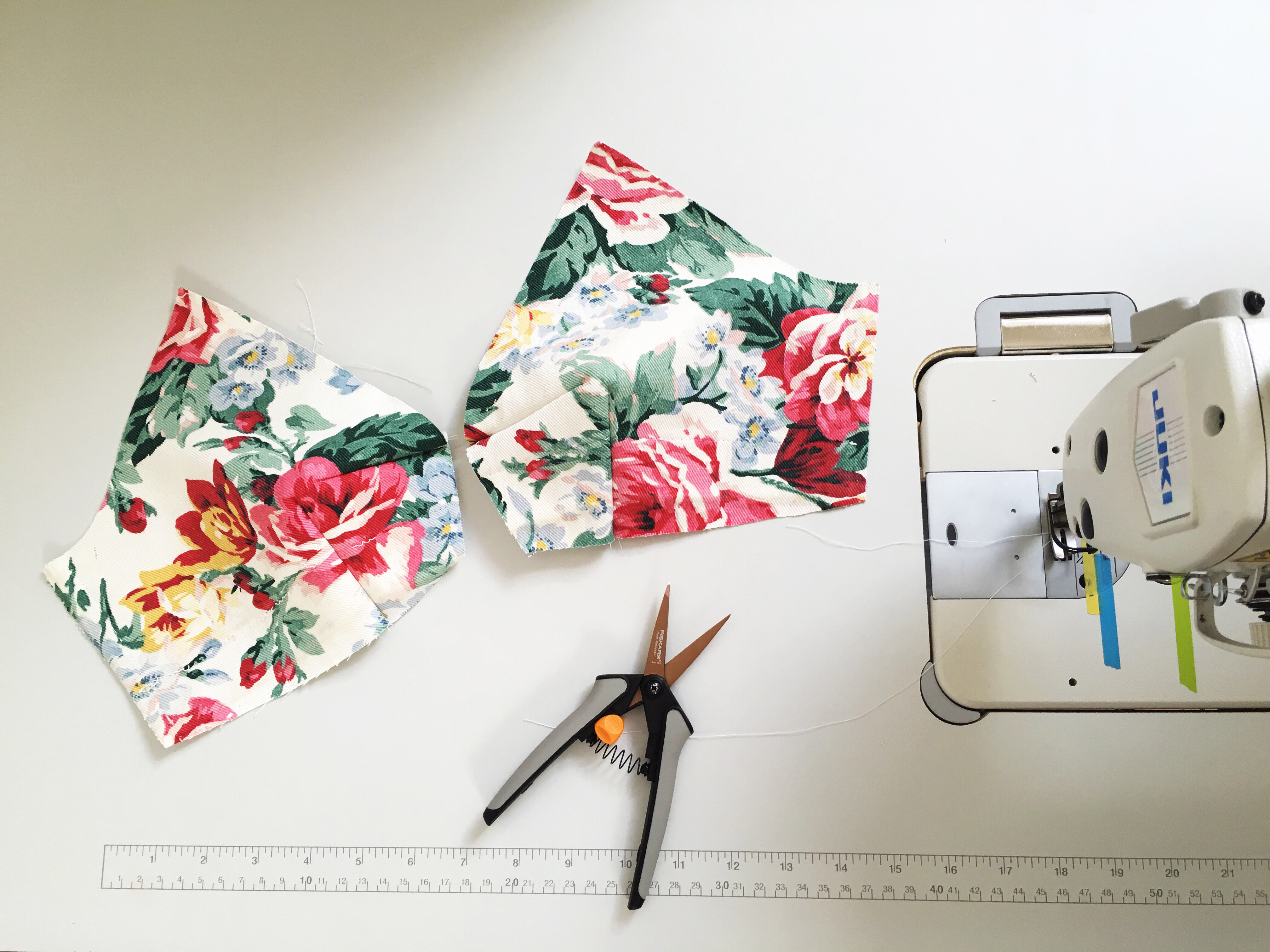
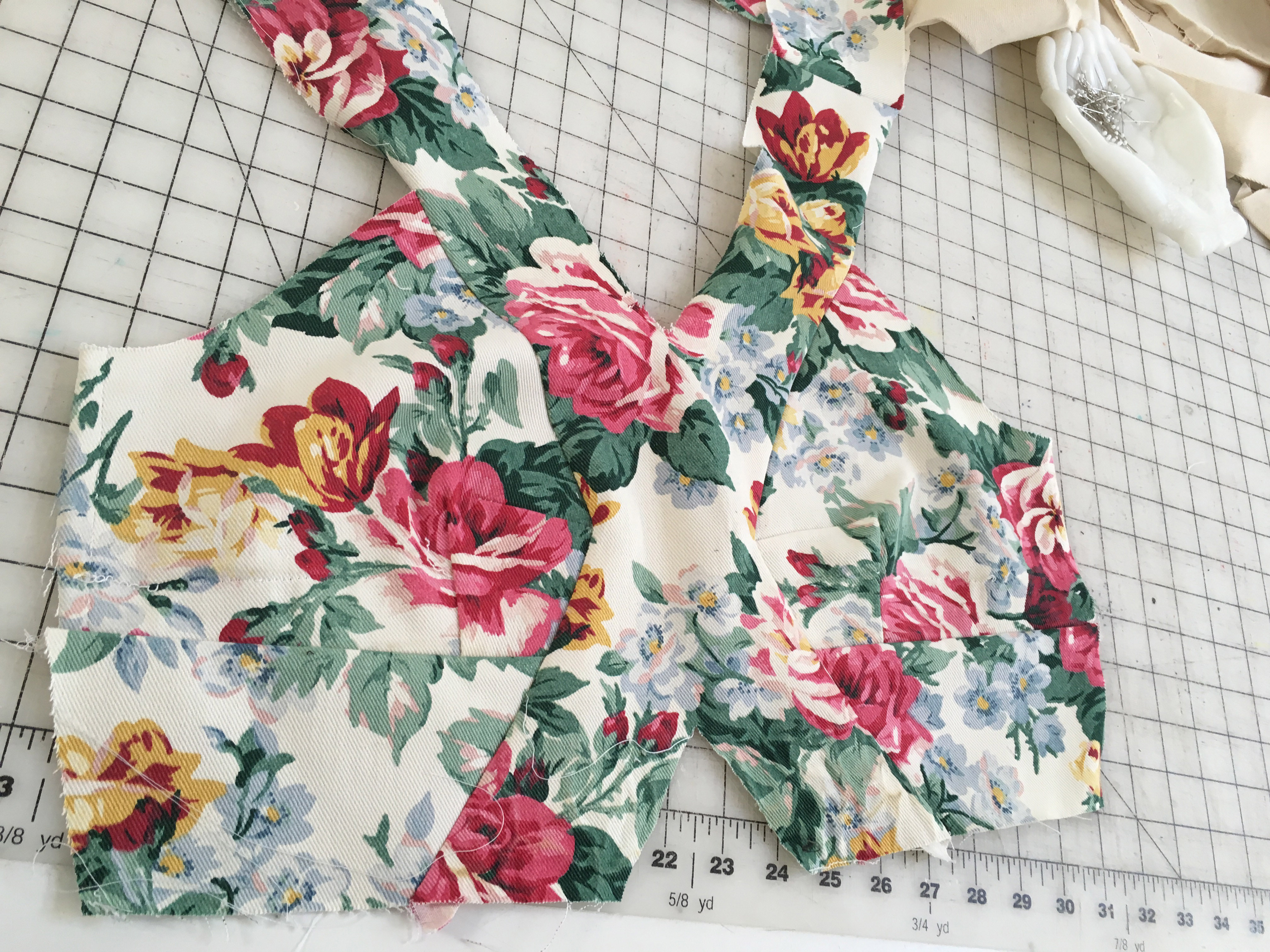
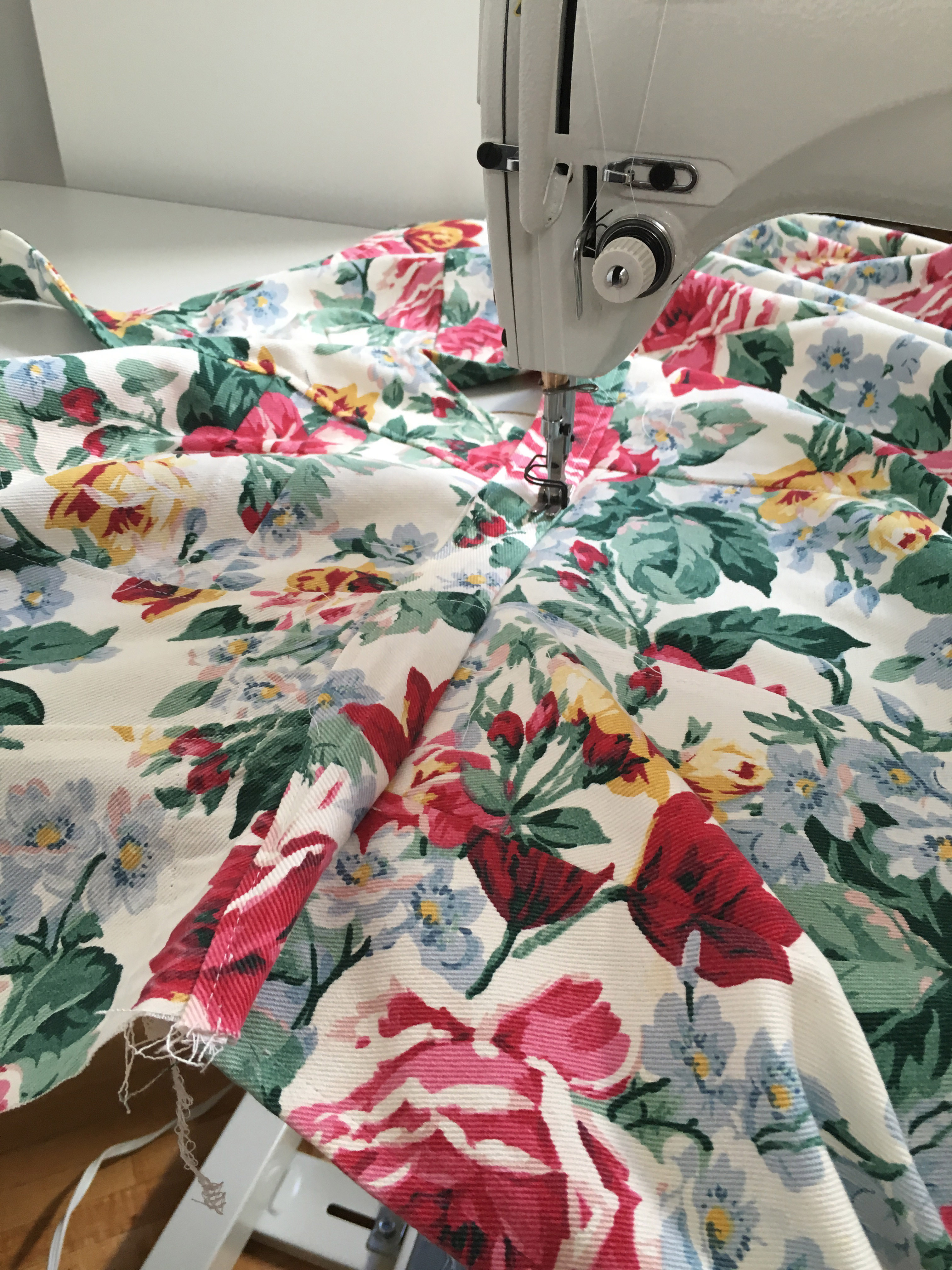
This was also the first thing I sewed using our new Juki industrial sewing machine and I LOVED it.
Delaney altered two patterns to create her dress from no fewer than four pairs of jeans.

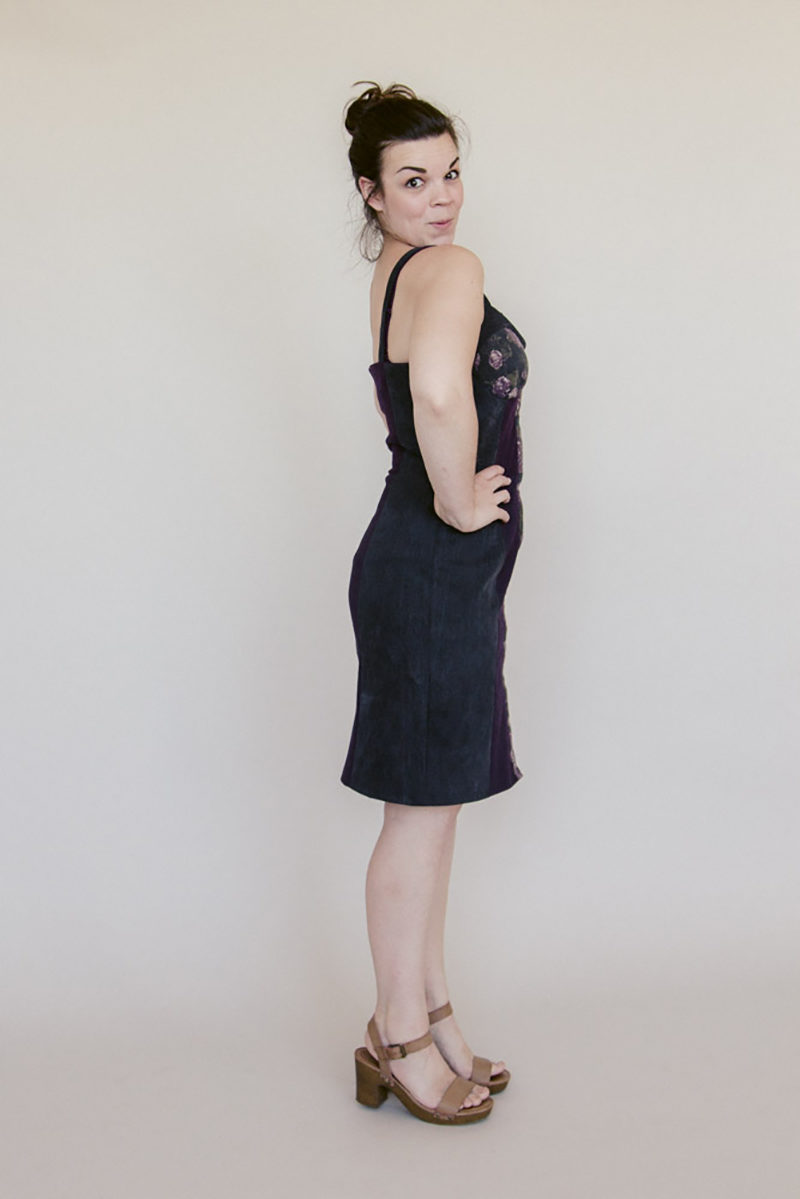
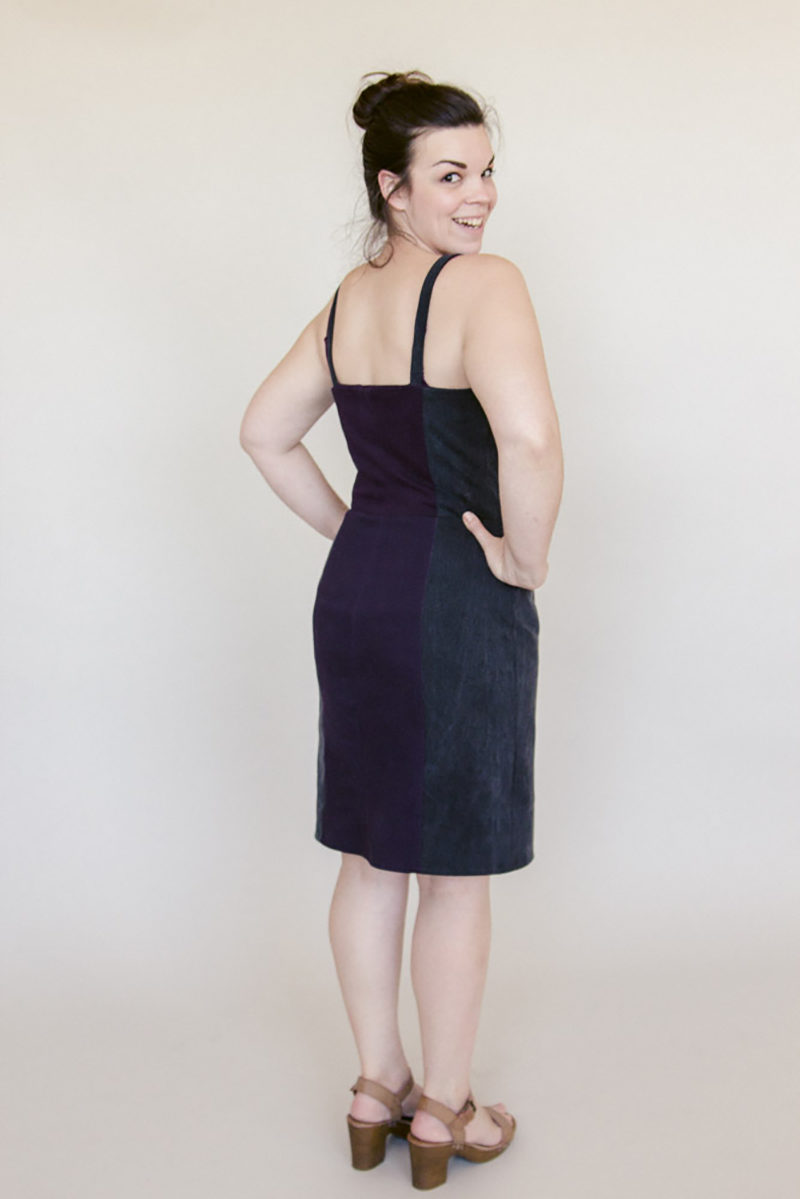
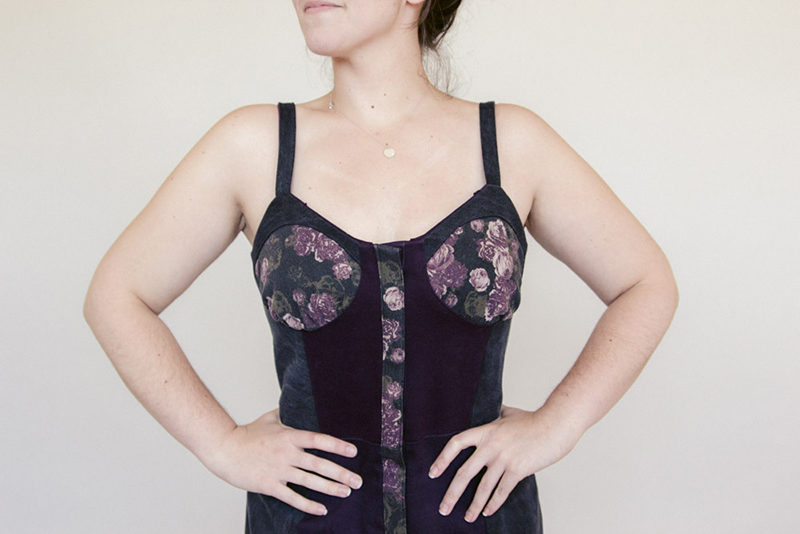
The skirt was modified from an older Bellville Sassoon pattern from Vogue, and the bodice from the “Madonna” bodice pattern from the book Famous Frocks by Sara Alm and Hannah McDevitt. She used one pair of size 50 men’s jeans in black, a dark floral pair, and two pairs of purple stretch denim.
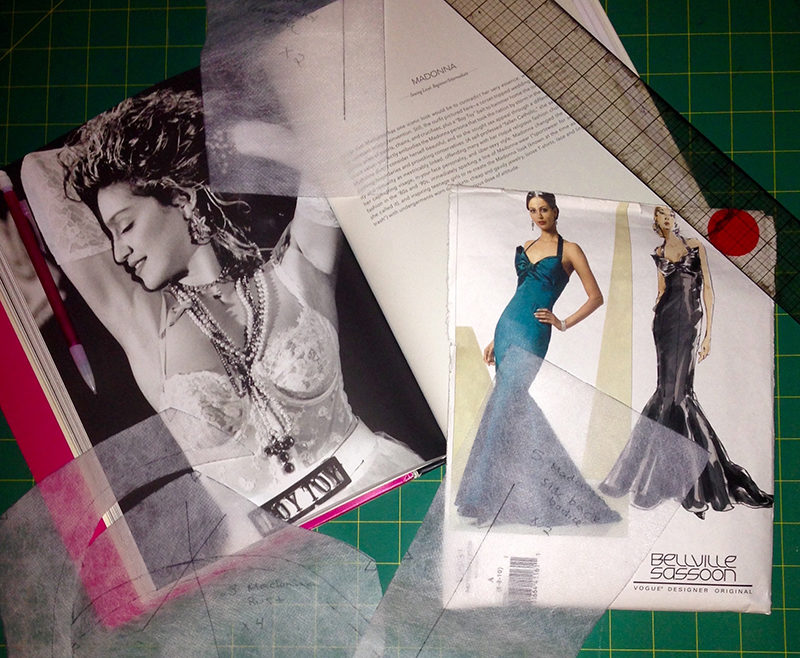

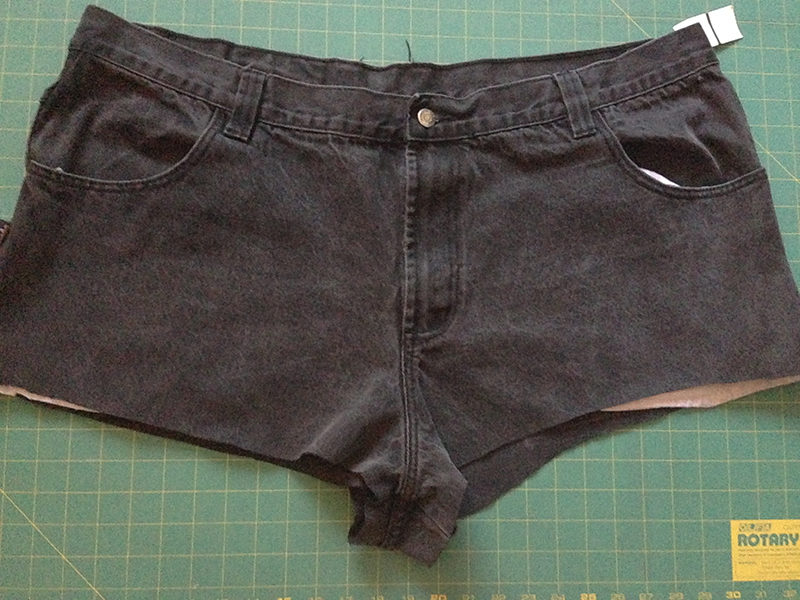
10 Tips for sewing denim
I find denim pretty easy to work with, actually. It’s strong, durable, doesn’t snag, is easy to cut, and it’s really satisfying to sew.
There are just a few tips and tricks (and tools) I try to keep in mind when working with denim.
- Choose the right design. Heavy denim works best with structured garments, It’s obviously great for pants and shorts, but also works well in jackets, fitted dresses, or skirts. But keep in mind that lighter denim can also be used to make more flowing garments, like full skirts, looser dresses, and button-ups.
- Grab a jeans needle. Every wondered what the difference is between an all-purpose needle and the ones marked “Jeans”? Jeans needles are specifically designed to puncture through multiple layers of heavy fabric. You can use the smaller ones (size 90/14) for lighter denim, but a 100/16 or 100/18 is better for heavy denim.
- Pay extra attention to grainlines. When you’re cutting, make sure that your grainlines are aligned correctly. If you cut your fabric off grain, you’re likely to encounter twisting. It was tempting to mess with grain when trying to squeeze out all the pieces from my original garment, but I made sure everything was cut straight either lengthwise or, if necessary, crosswise.
- Use lighter facings where necessary. Denim is bulky, You can cut down on that bulk by choosing lighter fabrics for inner details like facings.
- Reinforce seams with topstitching. Some denim garments (including tight dresses!) get a lot of stress. Use a heavier weight thread (topstitching or upholstery thread works) to topstitch seams from the right side and provide extra support. Use a regular all-purpose thread in the bobbin.
- Use a longer stitch length. If your denim is the typical heavyweight, jeans sort of denim, lengthen your stitches to about 3mm.
- Use heat and steam. Pressing denim is really important, especially if you want neat topstitching. Use a high heat setting on your iron and plenty of steam.
- Use a clapper. Don’t have a clapper? You should! It’s one of my favorite tools. A clapper allows you to apply sustained pressure to a seam to help get it really crisp and flat and eliminate bulk.
- Use sturdy closures. A garment is only as strong as its weakest part, so be sure to match your closure to the fabric. Heavy duty snaps, riveted jeans buttons, and heavy metal zippers all pair well with denim. For lighter denim (used for shirts, for example), you can go with standard closures.
- Finish your seams. Again, denim garments should be made to last! Denim can fray something awful, so unless that’s the effect you want, be sure to finish those seams. A flat felled seam is a classic choice on straight seams, but you can also serge your seams, use a mock flat-felled seam, or (my fave) bind them with a Hong Kong finish! Hong Kong seams are great on denim because the thick fabric disguises any extra bulk pretty well.
Those are my 10 favorite tips. Do you have any of your own you’d like to add?

 Sign In
Sign In

Comments
Kelly Rose
August 8, 2016 #
This is so timely! I’m in the middle of sewing a Wearing History Air Raid Suit out of denim for an event this weekend. I don’t think I’ve ever made anything out of denim before, so these tips are handy!
I’m felling all of my seams, which is period accurate, but it’s a pain, especially where seams intersect. My favorite tip is also how I ended up hitting my finger with a hammer while sewing yesterday. You can use a mallet, or a hammer with a smooth surface to smash bulky seam overlaps, for example where the shoulder seam meets the sleeve. It won’t lay flat, even if you press it, but a couple of good whacks with the hammer and it falls into line. Just be more careful than I was about where your fingers are.
Leila
August 8, 2016 #
Hammering bulky seams is my favorite denim sewing tip, too. It makes such a difference!
Kathy Traweek
August 10, 2016 #
Kelly, I would not buy denim because of the thick seems but I learned about a jene’s needle. I am going to Home Accents this afternoon and get some.
I would to find a commercial grade sewing machine that was reasonably priced, I would love to see it.
Sewing is more than a hobby it’s a labor of love. I have been asked why I didn’t sew for other people, make some extra money. But that would take the love away and make it a job. .I have a small couch and 2 wing back chairs and a setie (sp) that I am getting ready to upholstery. I have been looking for a certain shade of blue, and I think brushed denim would be great.
PsychicKathleen
August 8, 2016 #
I have been having so much fun seeing what all the makes are for this denim challenge! Both of your dresses are terrifically sexy :) Love them both!
Gretchen Potts
August 8, 2016 #
Beautiful dresses ladies! I think I may have had a pair of those floral denim jeans back in the day! Also so excited to see your new Juki! Got one of these little gems last spring and Im so in love with how smooth it sews.
francesca
August 9, 2016 #
Wow. Two gorgeous and alluring dresses. And Sarai, your tattoo looks incredible with that print!
Carolle
August 9, 2016 #
I can’t stop looking at Sarai’s dress…gorgeous make…possibly a future pattern release?
Leslie
August 9, 2016 #
I second that! Would love a pattern of this dress.
Chloe
August 9, 2016 #
Thirded!
Betty Jordan Wester
August 9, 2016 #
These are really cute! I love the use of floral denim in both!
Anna
August 9, 2016 #
Theres a wee problem with bulk in the seams of the hem. My machine seems to want to make smaller stitches as it goes over the hump created by multiple layers, and then once past the bulk the stitches become way too long. How do you get over the hump and retain a good stitch length?
Katie
August 9, 2016 #
Hey Anna! You should try using this tool and possibly using a walking foot.
edie
August 9, 2016 #
The “seam jack” seems like the perfect tool for me, but when I ask for it at my fabric store, shop for it online, or just google it, all I get is “a WHAT?” Is there another name for the seam jack, or better yet, do you know where I can purchase one. (I live in the Seattle area, but am visiting Portland early next month.
Thanks!
Linda
August 9, 2016 #
There are different things you can purchase, the Jean-a-ma-jig is pretty good, but I have also used some rolled up fabric with better success
edie
August 9, 2016 #
Thanks, Linda. At least this will give me a starting place to understanding how the process works. I’ve been plagued by getting over those humps for too long.
Miranda
August 9, 2016 #
Hmmm….I have a couple pairs of jeans hanging around waiting for me to do something with them.
WheelyBad
August 9, 2016 #
Amazing refashions and some very helpful hints. Have denim in various weights waiting for their moment, everything from stretch to old jeans in various weights that need taking in or that I’ve put aside to use in other things. I’ve seen with heavy calico and bull denim which is a similar weight and has similar properties. I love the hint from one poster to smash awkward seams with a hammer, brilliant! Love the tip to use Hong Kong finish too. My helpful hint is to use a jeans support under a standard presser foot to navigate big fat seam junctions. It’s a bit of plastic with a wide angle that you pop under the presser foot so the stitches stay even. I know they’re easily found in the UK. If I remember I will post back with a link in case anyone hasn’t come across them. The other thing I like to use is a walking foot, I also often choose my straight stitch plate for maximum control.
Happy stitching!
Theresa Holland
August 9, 2016 #
This post is so timely for me! I’m in the process of making a denim skirt (midweight off the bolt) and am trying to figure out if I should use interfacing or not… The waist is finished with a facing, not a waistband, and if I use denim for the facing, it seems unnecessary. Should I use denim without facing, or would a woven (quilting) cotton with interfacing work better? Thanks for any help!
Linda
August 9, 2016 #
I always use a lighter weight fabric for facings, as well as some interfacing, particularly if it has any stretch
Kathy Traweek
August 10, 2016 #
I hope you don’t think I’m a busy body but always put interfacing. Use the light weight fusible interfacing. After a few washings you will be glad you did.
Pressing the lapels or any place that will have a button and button holes will keep their new look shape
Sophie
August 10, 2016 #
Would you consider release the pattern of your dress Sarai? It is just wonderful and what I have been looking for!
Colleen Donfield
August 10, 2016 #
Make this a pattern! Please please please (begging you)!
Gen
August 10, 2016 #
Love both of these dresses! Kudos, Sarai, on squeezing those little pattern pieces out of the jeans. Talk about being resourceful! I like to prewash my denim by itself with a cupful of salt to set the color. I love the really deep inky indigo shades and the salt keeps the due from fading and rubbing off. Also, I hit up the thrift store for the biggest pair of men’s jeans I can find. They’re great for muslins!
Kathy Traweek
August 10, 2016 #
Great idea. Anything to save money. I always wait until around this time of the year because winter stock is coming in and the store’s want to get rid of all summer stock. Talk about saving money. When you see material that sold for $15 to $20 dollars a yard, 64 or 65 inches wide on the table with a dollar a yard.
Kathy Traweek
August 10, 2016 #
Hello everybody my Name is Kathy and I live in Alabama. I am 64 years old. When I was a little girl, like 5 or 6 I got into more trouble because I was always tearing my older sister’s clothes to make doll clothes. I doubt that a lot of you have ever learned to sew on a Singer peddle sewing machine. Believe me my short legs had a rough time stopping the peddle which resulting in many smashed toes. I wish I had that machine, just to own it.
I am proof that you don’t get too old to learn. I did not know that there was a special needle for jeans. I still don’t know what a claper is, but you can be rest assured that I will know as soon as I post this.
I worked in a Refinery for 26 years, with mostly men and they only had a few subjects to talk about and my sewing wad not one of then. As a matter of fact sewing was a female hobby.
I made both my daughter’s wedding gowns plus the brides maids dresses. That wedding took me 9 mo. Of continues work. But it turned out beautiful.
On May 13, 2001, Mother’s Day I was hurt and burned. I am right handed and of course that was the one that got most damage. I can’t flip and turn like I used to. I miss sewing. I miss my wood working projects. The last major piece was a swinging cradle for my first grandson. I still have it.
Ladies, when you have taught yourself how to do things, things you love and you lose your coordination it can be heartbreaking. But what you do then is learn something else.
Darby
August 17, 2016 #
Hope your hand is better soon and that your lifelong passion continues, Kathy!
Justine
August 10, 2016 #
I am loving both your body conscious dresses! Very glam and gorgeous! Thanks for the tips,too.